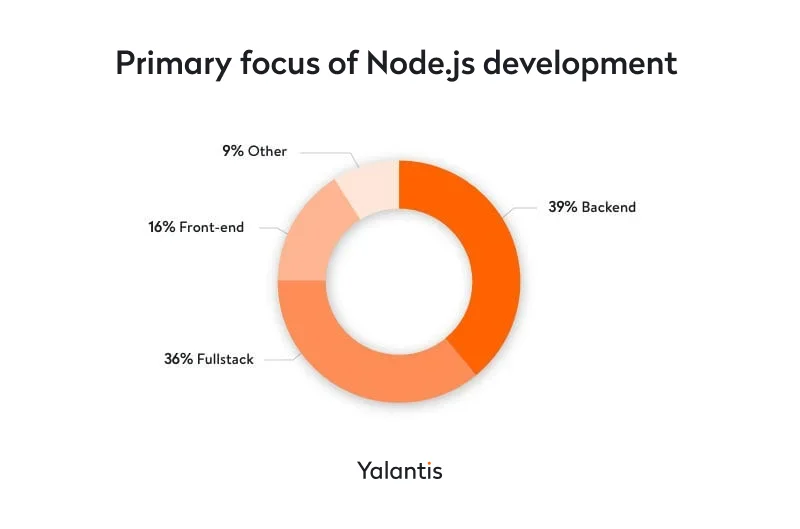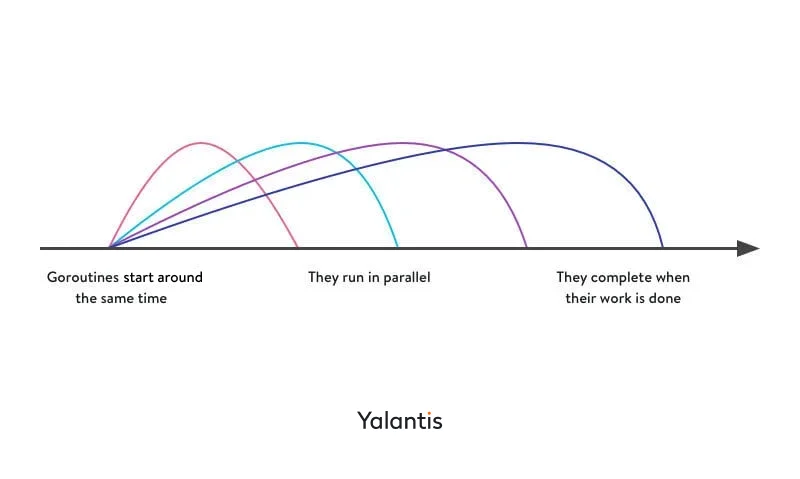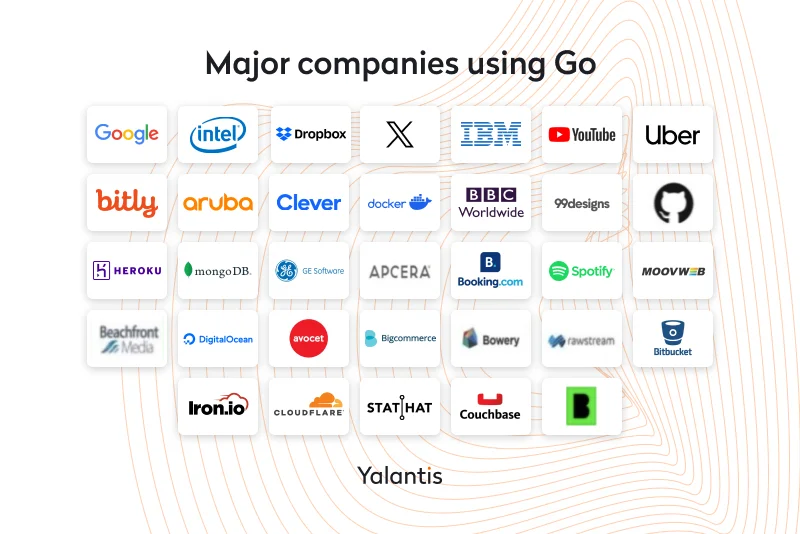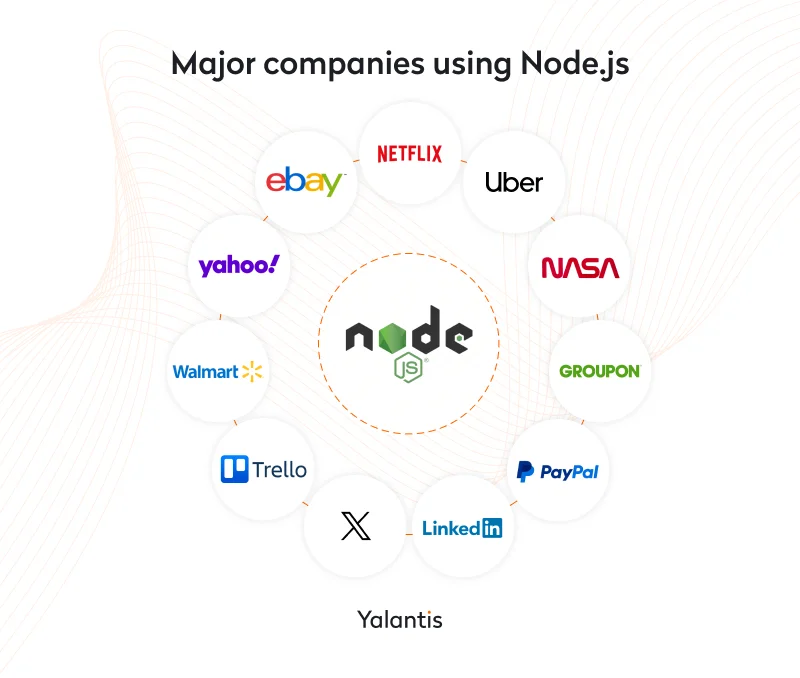Many factors define the quality of a web solution, including its performance under increasing load, code maintainability, and overall system security, which all rely on a high-capacity backend system.
In a landscape filled with backend technologies including Ruby, Node.js, Go, Python, and PHP, selecting the right technology stack is crucial. While navigating this diversity might pose a challenge, we’re here to help.
In this article, we closely examine Go and Node.js, both of which are known as robust backend technologies:
- Go, a language developed by Google, was recognized as one of the most promising languages in 2022.
- Node.js, a JavaScript runtime, was named the most widely used development tool in 2023.
Renowned companies such as Uber, UpGuard, and Koding have made the transition from Node.js to Go, while tech giants like Netflix remain loyal to Node.js. With each technology excelling in different domains, let’s explore which is the right fit for your project.
Exploring Go
Go, or Golang, is a compiled open-source programming language. First introduced by Google in 2009, Go aims to combine the best parts of existing programming languages while solving common pain points.
Like C++ and Java, Go is statically typed for efficiency. It also has syntax similarities to C for speed and simplicity. The result is a lightweight language optimized for building readable, reliable, and scalable software.
Read also: Why use the Go language for your project?
Becoming Go
Widespread adoption
The first stable release of Go came in 2011. It featured built-in support for concurrency with goroutines and channels that helped ensure hassle-free data exchange. It also included a garbage collector and testing tools out of the box.
Since then, Go has steadily gained popularity in the developer community. Tiobe named Go the Programming Language of the Year in 2009 and 2016. The PYPL Index confirms Go’s popularity, ranking it 12th out of 29 languages based on Google searches for learning tutorials. In the Stack Overflow Developer Survey 2023, Go was the 13th most popular programming language.
Notable companies using Go include Google, Uber, the BBC, SoundCloud, and Basecamp. Go has become a preferred choice for building scalable web applications and cloud-native applications. As developers continue to adopt Go for its simplicity, speed, and scalability, it’s poised for even greater growth. Its blend of features, like fast compile times, concurrency support, and minimalist syntax, make Go a worthy addition to any engineering team’s tech stack.
Primary use cases
Go excels as a systems language for services, APIs, web apps, and distributed systems. Its sweet spot is backend development, where efficiency and reliability are critical.
While Go is usable for frontend development, other languages like JavaScript are more common. Go isn’t ideal for processor-intensive tasks better handled by C++. But its versatility and focus on productivity make it a handy tool for all kinds of development.

Exploring Node.js
Node.js is a JavaScript runtime environment built on Google Chrome’s V8 engine. First introduced at JSConf in 2008, Node.js was quickly embraced by developers. It allows you to write JavaScript code on both the front end and back end without learning multiple languages.
Node.js is an open-source platform that runs on various operating systems. It excels at creating fast, scalable server-side applications and real-time services.

Widespread adoption
In 2014, an independent fork of Node.js, known as io.js, emerged. A year later, the io.js and Node.js communities merged to form the Node.js Foundation. Today, Node.js is the most popular JavaScript framework, while JavaScript holds the status of the #1 programming language on StackOverflow. Major companies have broadly adopted it, including Netflix, eBay, and Groupon, which use it for full-stack development.
At Yalantis, our recent Node.js projects include a live election data processing app, an IoT-based enterprise SaaS solution, and a wealth management platform.
Primary use cases
Node.js is primarily used for backend development and full-stack applications. It excels at handling server-side logic and APIs. While it has some frontend capabilities, Node.js is better suited for server-side tasks, real-time services, and asynchronous operations. Frontend developers often prefer dedicated UI frameworks over Node.js for their work.
Node.js’s flexibility and extensive libraries continue to make it a valuable choice across domains. It empowers developers to build fast, scalable applications using a single language for both the client and server sides.

Comparing Go vs Node.js
Now that we’ve provided background information about Node.js and Go, we see that both languages are modern and performant options used for backend web development but with different philosophies and strengths.
But if compared head to head, how do Go and Node.js stack up? Let’s compare them across a few key factors like scalability, performance, and error handling.
Short on time? Take a look at this quick comparison:
|
Aspect |
Node.js |
Go (Golang) |
|
Execution speed |
Interpreted language, affecting speed, but with high performance through asynchronous operations and optimization |
Compiled language with low overhead, making it fast and efficient |
|
Concurrency |
Supports optimal concurrency with Event Loop and worker threads |
Built-in goroutines for efficient concurrency |
|
Performance |
Medium |
Excellent |
|
Scalability |
Good for I/O-bound tasks |
Excellent for both CPU and I/O-bound tasks |
|
Ease of learning |
Relatively easy due to JavaScript familiarity |
Generally easy to learn, especially for experienced developers |
|
Community & ecosystem |
Large and active community, extensive npm package ecosystem |
Growing community, rich standard library, and support for modules |
|
Web development |
Strong for server-side; supports frontend development with frameworks like Express.js |
Strong for server-side; not typically used for frontend development |
|
Use cases |
Ideal for web servers, APIs, and real-time applications |
Ideal for microservices, system-level programming, and high-performance applications |
|
Error handling |
Callbacks, promises, async/await |
Built-in error handling and return values |
|
Tooling |
Abundance of development tools and libraries |
Strong tooling support, including gofmt, go vet, and more |
|
Deployment |
Easy deployment with various hosting options |
Simple deployment as a single binary with no runtime dependencies |
|
Static typing |
Dynamic typing |
Strongly typed language |
|
Learning curve |
Lower for beginners familiar with JavaScript |
Moderate for newcomers, quicker for experienced developers |
For a more detailed comparison of different criteria, keep reading our guide.
Criterion #1: Performance
In terms of raw performance, Go is the indisputable leader. But in real life, Node.js and Go show equally good performance.
Go
Go is renowned for its remarkable performance and is often likened to C and C++. The absence of a virtual machine, along with its compilation to machine code, ensures that Go programs execute swiftly, without the need for warm-up time.
Furthermore, Go boasts a built-in garbage collector that diligently manages memory, identifying and releasing unneeded memory to reduce the risk of security vulnerabilities. This robust memory management, combined with Go’s small memory footprint and fast performance, makes it an ideal choice for building microservices and generating statically linked binaries.
Node.js
Node.js offers unique performance characteristics of its own. Inherited from JavaScript, its asynchronous and non-blocking nature allows Node.js to perform small tasks in the background, ensuring that they don’t disrupt the main thread. Additionally, Node.js harnesses the power of the V8 engine, renowned as one of the fastest JavaScript engines.
Node.js’s code reusability is another standout feature. This trait is particularly valuable for event-based applications, such as for real-time data updates, making it a popular choice for instant messaging, video chats, and online gaming.
In real-world scenarios, notable organizations like PayPal and Medium have experienced significant benefits from using Node.js. PayPal saw a 200 millisecond reduction in page load times and a 35% decrease in average response times after migrating from Java to Node.js. Similarly, Medium, an online publishing platform, leveraged Node.js’s event-driven, non-blocking architecture to achieve remarkable performance, scalability, and enhanced user experiences.
For further performance comparisons, you can refer to synthetic tests conducted by The Computer Language Benchmarks Game.
| binary-trees | ||||
|
source |
secs |
mem |
gz |
cpu secs |
|
Node js |
6.37 |
1295776 |
711 |
19.51 |
|
Go |
14.69 |
642688 |
666 |
58.49 |
Criterion #2: Scalability and concurrency
Concurrency allows a program to run multiple tasks simultaneously and communicate between them. It’s an effective way to utilize the CPU and boost app performance.
Both Go and Node.js are capable of efficiently handling large numbers of concurrent connections and requests. However, at a large scale, Go may have a slight advantage due to its compiled nature.
Go
Concurrency is a central focus in Go, making it a robust choice for large software projects. Go provides developers with channels and goroutines, enabling efficient organization and execution of concurrent tasks.
Goroutines are lightweight, initially occupying just 4 KB of memory, in stark contrast to operating system threads, which begin at 1 MB. This allows developers to run thousands of goroutines simultaneously without excessive RAM use. Communication between goroutines is facilitated through channels, simplifying program structure and maintainability.

Node.js
Node.js uses an event-driven, non-blocking input/output (I/O) model that makes it lightweight and efficient for handling I/O-intensive workloads.
However, Node.js executes on a single thread. So CPU-intensive tasks can block the event loop and prevent other I/O operations from being handled promptly. This can lead to program slowdowns and frustrating user experiences.
Criterion #3: Community & ecosystem
Node.js and Go are open-source, with communities contributing to their development. While both have GitHub repositories, they differ in size and focus. Node.js has a mature and vibrant community, while Go’s community is smaller but growing, backed by Google’s support.
Go
The annual GopherCon brings Go developers worldwide together to discuss new opportunities and advancements. This conference has played a pivotal role in attracting more developers to contribute to the Go community and its projects.
A 2023 Golang survey underlines high levels of satisfaction among Go developers and reinforces Go’s status as a prominent choice for efficient and scalable software solutions.
Node.js
The Node.js Foundation actively promotes widespread adoption, with a dedicated security team and long-term support plans for stability. The Technical Steering Committee, consisting of 11 regular members and over 3,200 contributors, further demonstrates the community’s vitality.
Notable companies like GoDaddy, Intel, IBM, Microsoft, PayPal, and NodeSource are active members of the Node.js Foundation. The community hosts the annual Node+JS Interactive event to introduce improvements and changes, and Node.js boasts over one billion downloads and 98,000 GitHub stars to date.
Criterion #4: Tooling
Node.js offers a wide array of development tools and frameworks, making it an attractive choice. However, with its smaller toolkit compared to Node.js, Go provides some powerful tools of its own.
Node.js
Node.js provides a wealth of development tools and frameworks thanks to its event-based framework and microservices architecture. This architecture allows for easily adding new components to your app. The Node.js package manager (npm) is a standout feature, offering access to approximately 1,300,000 ready-made tools. However, navigating them can be challenging due to the lack of a well-structured list.
Go
In contrast, Go offers a more streamlined selection of tools, largely thanks to its comprehensive standard library, which often negates the need for third-party support. On the other hand, Go lacks a built-in GUI library.
Notably, despite having fewer tools compared to Node.js, Go still boasts robust tools like Gofmt, Godoc, GoMetaLiner, and Go run.
Criterion #5: Error handling
Go and Node.js differ in their error handling approaches due to different language and runtime characteristics. For example, Go focuses on explicit error handling with return values and encourages error wrapping. In contrast, Node.js follows an event-driven, callback-based approach, with recent improvements like Promises and async/await for structured error handling. So both have their merits.
Go
Strong typing and explicit errors. Go is a statically typed language, which means that variable types are known at compile time. Go encourages the use of explicit error handling through a combination of return values and error type. Functions often return two values: the result and an error. Developers are expected to check the error value explicitly.
result, err := someFunction()
if err != nil {
// Handle the error
}
Error wrapping. Go provides a mechanism for wrapping errors to add context and details to an error. This can help in creating a chain of errors to understand the root cause of an issue.
err := someFunction()
if err != nil {
return fmt.Errorf("additional context: %w", err)
}
Panic and recover. In exceptional cases, Go allows for panics (similar to exceptions in other languages), which can be caught and recovered using the recover function. However, panics are typically reserved for unrecoverable errors.
Node.js
Asynchronous nature. Node.js has an asynchronous, event-driven architecture. Many operations are non-blocking and use callbacks or Promises to handle errors.
someFunction((err, result) => {
if (err) {
// Handle the error
}
});
Promise-based error handling. With the advent of Promises and async/await in JavaScript, error handling has become more structured and readable in Node.js.
try {
const result = await someFunction();
} catch (error) {
// Handle the error
}
Event emitters. Node.js often uses event emitters for handling errors in event-driven applications. Error events can be emitted and then handled.
emitter.on('error', (err) => {
// Handle the error
});
Exception handling. Node.js provides a way to catch unhandled exceptions using the process.on(‘uncaughtException’) event. However, it’s generally recommended to avoid unhandled exceptions and handle errors gracefully.
Real-life experience of major tech players with Go and Node.js
Now, let’s see what popular companies say about using Go and Node.js for software development.
Go
Uber. In 2016, Uber migrated from Node.js to Go to improve the performance of their geofence lookup microservice. This microservice turned out to be the company’s service with the most queries per second (QPS).
There were two main reasons why Uber decided to migrate to Go:
- The dynamically typed and interpreted nature of Node.js hinders the ability to efficiently handle CPU-intensive point-in-polygon algorithms.
- To ensure that they had the freshest geofence information, Uber needed to refresh information from several sources simultaneously. While this took a lot of time with single-threaded Node.js, Go’s Goroutines enabled parallel execution and provided an easier learning curve.
Overall, Uber developers have praised Go for its reliability, ease of adoption, and maintenance, achieving 99.99% uptime and handling peak loads of 170,000 queries per second.

Basecamp. Go has found its way into Basecamp’s backend services and infrastructure, and Basecamp has highlighted Go’s simplicity. Noah Lorang, a data analyst at Basecamp, says that Go is a great solution for building data pipelines thanks to its goroutines. In his mind, Go’s main pros are its robust standard library, simple syntax, and easy refactoring and deployment processes.
Node.js
Netflix. The whole user interface of the Netflix app is built with Node.js. The Netflix development team chose Node.js because they wanted a fast and lightweight application. By moving to Node.js, they achieved a 70% reduction in app startup time.
Groupon. Under the guidance of director of software engineering Adam Geitgey, Groupon switched from Ruby to Node.js. They made this change because JavaScript is nearly a universal language, making it simple for their frontend developers to adopt Node.js. Additionally, Node.js performance empowers Groupon to efficiently handle over 425,000 active deals.

These real-world experiences showcase how Go and Node.js cater to specific requirements, delivering improved performance and ease of use in different contexts.
So, who wins the Node.js vs Go battle?
To sum it up, Go excels in handling high loads and is a strong contender for microservices and enterprise-scale projects. On the other hand, Node.js offers a vast array of ready-made solutions, reducing custom software development time and providing versatility for various development challenges.
The key takeaway is that there’s no one-size-fits-all answer; the right choice depends on the type and characteristics of your application. Each tool has its strengths and is tailored for different tasks.
Struggling to make a decision? Feel free to reach out to us and we’ll assist you in making the right choice based on your project’s requirements.
Have a web app in mind?
Let’s disrupt the web world together
Rate this article
4/5.0
based on 1,661 reviews








